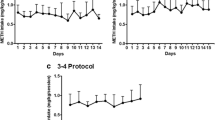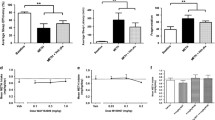Abstract
Rationale
Clinical trials show that chronic cocaine users suffer from sleep disturbances and preclinical research has shown that acute sleep deprivation increases the rate of cocaine self-administration in rats.
Objective
This study examined the effect of cocaine self-administration on behavioral indices of sleep and alternatively the effect of sleep disruption on cocaine-maintained responding by rhesus monkeys.
Methods
Seven adult rhesus monkeys, fitted with Actical® activity monitors, were trained to respond under a concurrent choice paradigm with food (three 1.0-g pellets) and cocaine (0.003–0.3 mg/kg) or saline presentation. For each monkey, the lowest preferred dose of cocaine (>80 % cocaine choice) was determined. Activity data were analyzed during lights out (2000-0600) to determine sleep efficiency, sleep latency, and total activity counts. Subsequently, the monkeys’ sleep was disrupted (every hour during lights-out period) the night prior to food–cocaine choice sessions.
Results
Self-administration of the preferred dose of cocaine resulted in a significant decrease in sleep efficiency, with a significant increase in total lights-out activity. Sleep disruption significantly altered behavioral indices of sleep, similar to those seen following cocaine self-administration. However, sleep disruption did not affect cocaine self-administration under concurrent choice conditions.
Conclusions
Based on these findings, cocaine self-administration does appear to disrupt behavioral indices of sleep, although it remains to be determined if treatments that improve sleep measures can affect future cocaine taking.





Similar content being viewed by others
References
Ancoli-Israel S, Cole R, Alessi C, Chambers M, Moorcroft W, Pollak CP (2003) The role of actigraphy in the study of sleep and circadian rhythms. Sleep 26:342–392
Andersen ML, Kessler E, Murnane KS, McClung JC, Tufik S, Howell LL (2010) Dopamine transporter-related effects of modafinil in rhesus monkeys. Psychopharmacology (Berl) 210:439–448
Andersen ML, Sawyer EK, Carroll FI, Howell LL (2012) Influence of chronic dopamine transporter inhibition by RTI-336 on motor behavior, sleep, and hormone levels in rhesus monkeys. Exp Clin Psychopharmacol 20:77–83
Andersen ML, Diaz MP, Murnane KS, Howell LL (2013) Effects of methamphetamine self-administration on actigraphy-based sleep parameters in rhesus monkeys. Psychopharmacology (Berl) 227(1):101–107
Anderson C, Platten CR (2011) Sleep deprivation lowers inhibition and enhances impulsivity to negative stimuli. Behav Brain Res 217:463–466
Balzamo E, Santucci V, Seri B, Vuillon-Cacciuttolo G, Bert J (1977) Nonhuman primates: laboratory animals of choice for neurophysiological studies of sleep. Lab Anim Sci 27:879–886
Barkoukis TJ, Avidan AY (eds) (2007) Review of sleep medicine, 2nd edn. Butterworth-Hinemann, Pennsylvania, pp. 169, 179
Barrett CE, Noble P, Hanson E, Pine DS, Winslow JT, Nelson EE (2009) Early adverse rearing experiences alter sleep–wake patterns and plasma cortisol levels in juvenile rhesus monkeys. Psychoneuroendocrinology 34:1029–1040
Benedict C, Brooks SJ, O’Daly OG, Almen MS, Morell A, Aberg K, Gingnell M, Schultes B, Hallschmid M, Broman JE, Larsson EM, Schioth HB (2012) Acute sleep deprivation enhances the brain’s response to hedonic food stimuli: an fMRI study. J Clin Endocrinol Metab 97:E443–E447
Brondel L, Romer MA, Nougues PM, Touyarou P, Davenne D (2010) Acute partial sleep deprivation increases food intake in healthy men. Am J Clin Nutr 91:1550–1559
Centers for Disease Control and Prevention (2012). http://www.cdc.gov/tobacco/data_statistics/fact_sheets/economics/econ_facts/. Accessed 14 Dec 2012
Clark CP, Gillin JC, Golshan S, Demodena A, Smith TL, Danowski S, Irwin M, Schuckit M (1998) Increased REM sleep density at admission predicts relapse by three months in primary alcoholics with a lifetime diagnosis of secondary depression. Biol Psychiatry 43:601–607
Crean RD, Davis SA, Von Huben SN, Lay CC, Katner SN, Taffe MA (2006) Effects of (±)3,4-methylenedioxymethamphetamine, (±)3,4-methylenedixoyamphetamine and amphetamine on temperature and activity in rhesus macaques. Neuroscience 142:515–525
Daley JT, Turner RS, Freeman A, Bliwise DL, Rye DB (2006) Prolonged assessment of sleep and daytime sleepiness in unrestrained Macaca mulatta. Sleep 29:221–231
Dalley JW, Fryer TD, Brichard L, Robinsin ES, Theobald DE, Laane K, Pena Y, Murphy ER, Shah Y, Probst K, Abakumova I, Aigbirhio FI, Richards HK, Hong Y, Baron JC, Everitt BJ, Robbins TW (2007) Nucleus accumbens D2/3 receptors predict trait impulsivity and cocaine reinforcement. Science 315:1267–1270
Drummond SP, Gillin JC, Smith TL, DeModena A (1998) The sleep of abstinent pure primary alcoholic patients: natural course and relationship to relapse. Alcohol Clin Exp Res 22:1796–1802
Fakier N, Wild LG (2011) Associations among sleep problems, learning difficulties and substance use in adolescence. J Adolesc 34:717–726
Gillin JC, Smith TL, Irwin M, Butters N, Demodena A, Schuckit M (1994) Increased pressure for rapid eye movement sleep at time of hospital admission predicts relapse in nondepressed patients with primary alcoholism at 3-month follow-up. Arch Gen Psychiatry 51:189–197
Hamilton LR, Czoty PW, Gage HD, Nader MA (2010) Characterization of the dopamine receptor system in adult rhesus monkeys exposed to cocaine throughout gestation. Psychopharmacology (Berl) 210:481–488
Hamilton LR, Czoty PW, Nader MA (2011) Behavioral characterization of adult male and female rhesus monkeys exposed to cocaine throughout gestation. Psychopharmacology (Berl) 213:799–808
Harwood H (2000) Updating Estimates of the Economic Costs of Alcohol Abuse in the United States: Estimates, Update Methods, and Data. Report prepared by The Lewin Group for the National Institute on Alcohol Abuse and Alcoholism. Based on estimates, analyses, and data reported in Harwood, H.; Fountain, D.; and Livermore, G. The Economic Costs of Alcohol and Drug Abuse in the United States 1992. Report prepared for the National Institute on Drug Abuse and the National Institute on Alcohol Abuse and Alcoholism, National Institutes of Health, Department of Health and Human Services. NIH Publication No. 98-4327. National Institutes of Health, Rockville, MD
Hasler BP, Holm SM, Jakubcak JL, Silk JS, Ryan ND, Phillips ML, Dahl RE, Forbes EE (2012) Weekend-weekday advances in sleep timing are associated with altered reward-related brain function in healthy adolescents. Biol Psychol 91:334–341
Knapp CM, Datta S, Ciraulo DA, Kornetsky C (2007) Effects of low dose cocaine on REM sleep in the freely moving rat. Sleep Biol Rhythms 5:55–62
Kushida CA, Chang A, Gadkary C, Guilleminault C, Carrillo O, Dement WC (2001) Comparison of actigraphic, polysomnographic, and subjective assessment of sleep parameters in sleep-disoriented patients. Sleep Med 2:389–396
Landolt HP, Gillin JC (2001) Sleep abnormalities during abstinence in alcohol-dependent patients. Aetiology and management. CNS Drugs 15:413–425
Martinez D, Broft A, Foltin RW, Slifstein M, Hwang DR, Huang Y, Perez A, Frankle WG, Cooper T, Kleber HD, Fischman MW, Laruelle M (2004) Cocaine dependence and D2 receptor availability in the functional subdivisions of the striatum: relationship with cocaine-seeking behavior. Neuropsychopharmacology 29:1190–1202
Masuda K, Zhadanova IV (2010) Intrinsic activity rhythms in Macaca mulatta: their entrainment to light and melatonin. J Biol Rhythms 25:361–371
Moeller FG, Barratt ES, Dougherty DM, Schmitz JM, Swann AC (2001) Psychiatric aspects of impulsivity. Am J Psychiatry 158:1783–1793
Morgan D, Grant KA, Gage HD, Mach RH, Kaplan JR, Prioleau O, Nader SH, Buchheimer N, Ehrenkaufer RL, Nader MA (2002) Social Dominance in monkeys: dopamine D2 receptors and cocaine self-administration. Nat Neurosci 5:169–174
Morgan PT, Pace-Schott EF, Sahul ZH, Coric V, Stickgold R, Malison RT (2006) Sleep, sleep-dependent procedural learning and vigilance in chronic cocaine users: evidence for occult insomnia. Drug Alcohol Depend 82:238–249
Morgan PT, Pace-Schott EF, Sahul ZH, Coric V, Stickgold R, Malison RT (2008) Sleep architecture, cocaine and visual learning. Addiction 103:1344–1352
Nader MA, Morgan D, Gage HD, Nader SH, Calhoun TL, Buchheimer N et al (2006) PET imaging of dopamine D2 receptors during chronic cocaine self-administration in monkeys. Nat Neurosci 9:1050–1056
National Institute of Drug Abuse (2010) Cocaine: Abuse and Addiction. http://www.drugabuse.gov/publications/research-reports/cocaine-abuse-addiction.Accessed 14 Dec 2012
National Sleep Foundation (NSF) (2006) Sleep–wake cycle: its physiology and impact on health. Washington, DC
Pejovic S, Vgontzas AN, Basta M, Tsaoussoglou M, Zoumakis E, Vgontzas A, Bixler EO, Chrousos GP (2010) Leptin and hunger levels in young healthy adults after one night of sleep loss. J Sleep Res 19:552–558
Perry JL, Larson EB, German JP, Madden GJ, Carroll ME (2005) Impulsivity (delay discounting) as a predictor of acquisition of IV cocaine self-administration in female rats. Psychopharmacology (Berl) 178:193–201
Puhl MD, Fang J, Grigson PS (2009) Acute sleep deprivation increases the rate and efficiency of cocaine self-administration, but not the perceived value of cocaine reward in rats. Pharmacol Biochem Behav 94:262–270
Sadeh A (2011) The role and validity of actigraphy in sleep medicine: an update. Sleep Med Rev 15:259–267
Sadeh A, Acebo C (2002) The role of actigraphy in sleep medicine. Sleep Med Rev 6:113–124
Sadeh A, Hauri PJ, Kripke DF, Lavie P (1995) The role of actigraphy in the evaluation of sleep disorders. Sleep 18:288–302
Substance Abuse and Mental Health Services Administration (2011). Results from the 2010 National Survey on Drug Use and Health: Summary of National Findings, NSDUH, series H-41, HHS Publication No. (SMA) 11-4658. Substance Abuse and Mental Health Services Administration, Rockville, MD
U.S. Department of Justice, National Drug Intelligence Center (2010) National Drug Threat Assessment. www.justice.gov/ndic/pubs38/38661/index.htm. Accessed 14 Dec 2012
Volkow ND, Fowler JS, Wang GJ, Hitzemann R, Logan J, Schlyer DJ et al (1993) Decreased dopamine D2 receptor availability is associated with reduced frontal metabolism in cocaine abusers. Synapse 14:169–177
Volkow ND, Wang GJ, Fowler JS, Logan J, Gatley SJ, Gifford A et al (1999) Prediction of reinforcing responses to psychostimulants in humans by brain D2 dopamine receptors. Am J Psych 156:1440–1443
Volkow ND, Wang GJ, Telang F, Fowler JS, Logan J, Wong C, Ma J, Pradhan K, Tomasi D, Thanos PK, Ferre S, Jayne M (2008) Sleep deprivation decreases binding of [11C] raclopride to dopamine D2/D3 receptors in the human brain. J Neurosci 28:8454–8461
Volkow ND, Tomasi D, Wang GJ, Telang F, Fowler JS, Logan J, Benveniste H, Kim R, Thanos PK, Ferre S (2012) Evidence that sleep deprivation downregulates dopamine D2R in ventral striatum in the human brain. J Neurosci 32:6711–6717
Weiss AR, Johnson NL, Berger NA, Redline S (2010) Validity of activity-based devices to estimate sleep. J Clin Sleep Med 6:336–342
Acknowledgments
We would like to thank Tonya Calhoun and Michael Coller for excellent technical assistance and Dr. Kevin Murnane for assistance with analysis of sleep measures and Dr. Paul Czoty for comments on an earlier version of the manuscript. This research was supported by the National Institute on Drug Abuse grant DA025120.
Financial disclosures
The authors declare no conflicts of interest.
Author information
Authors and Affiliations
Corresponding author
Rights and permissions
About this article
Cite this article
Brutcher, R.E., Nader, M.A. The relationship between cocaine self-administration and actigraphy-based measures of sleep in adult rhesus monkeys. Psychopharmacology 229, 267–274 (2013). https://doi.org/10.1007/s00213-013-3101-1
Received:
Accepted:
Published:
Issue Date:
DOI: https://doi.org/10.1007/s00213-013-3101-1




